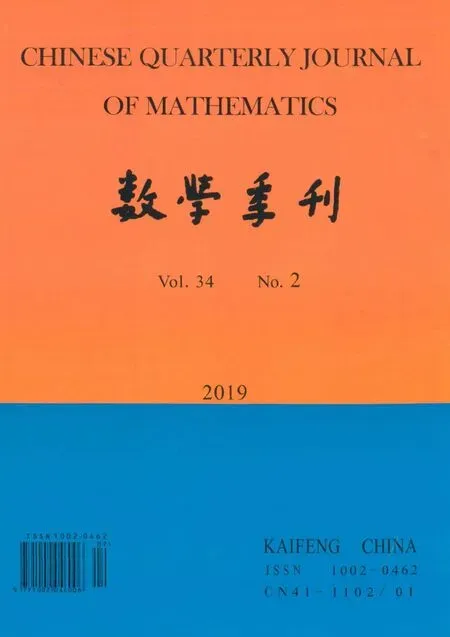Two Geometric Inequalities in Spherical Space
ZHOU Yong-guo
(Mingda middle school,Changsha,Hunan,410000,China)
Abstract:In this paper,by using the theory and method of distance geometry,we study the geometric inequality of a n-dimensional simplex in the spherical space and establish two geometric inequalities involving the edge-length and volume of one simplex and the volume,height and(n-1)-dimensional volume of the side of another simplex in the n-dimensional spherical space.They are the extensions of the results[10]in the n-dimensional Euclidean geometry to the n-dimensional spherical space.
Key words:spherical space;simplex;volume;edge-length;height;inequality
§1.Introduction and Main Results
Research achieveents on geometric inequalities in high-dimensional Euclidean space have been fruitful since 1980s in the 20th Century([1]).In particular,the work of Chinese mathematicians Lu Yang and Jingzhong Zhang on establishing several profound and elegant inequalities has been highly recognized nationwide by the international society([2-6]).In the last two decades,researchers on distance geometry attempted to extend these inequalities in Euclidean space.However,the development of high-dimensional geometric inequalities in non-Euclidean space was quite slow.In 2006,Professor Dinghua Yang([7])established several fundamental geometric inequalities in high-dimensional non-Euclidean space.Later,Professor Shiguo Yang([8])obtained several geometric inequalities on the volume,circumradius,inradius and edgelength of an n-dimensional simplex in the spherical space.More recently,Shiguo Yang obtained the Zhang-Yang type inequality([9])in n-dimensional spherical space.In this paper,we study the geometric inequality problems involving two n-dimensional simplexes in the spherical space,and establish two geometric inequalities on the edge-length and volume of one simplex and the volume,height and(n-1)-dimensional volume of the side of another simplex in n-dimensional spherical space.They are the extensions of the existing results in n-dimensional Euclidean geometry([10])to that in n-dimensional spherical space.
Let Ψk=Ak1,Ak2,···,Ak(n+1)(k=1,2)denote two n-dimensional simplexes in ndimensional Euclidean space,with edge-length|AkiAkj|=akij(k=1,2;0≤i Suppose the set of all points on the sphere with origin o and radius ρ in(n+1)-dimensional Euclidean space is For arbitrary two points x(x1,x2,···,xn+1)and y(y1,y2,···,yn+1)in Sn,we defines the distance to be the smallest non-negative real number satisfying Let Ω ={A0,A1,···,An}and Ω′={A′0,A′2,···,A′n}be two n-dimensional spherical space Sn(K)with edge-length=aijand=a′ij(0≤ i In this work we study the inequality relationship between the geometric quantities edgelength,volume,(n-1)-dimensional volume and height of the side for two simplexes in spherical space.We establish the following two geometric inequalities. Theorem 1 For two n-dimensional simplexes Ω, Ω′in n-dimensional spherical space Sn(K),we have The equality in(1.4)holds when Ω,Ω′are both regular simplex. Theorem 2 For two n-dimensional simplexes Ω, Ω′in n-dimensional spherical space Sn(K),we have The equality in(1.5)holds when both Ω,Ω′are regular simplexes. In order to prove the two theorems above,we introduce the following lemmas: Lemma 1[9]For n-dimensional simplex Ω in Sn(K)and a real number mi> 0(i=0,1,···,n),we have The equality in(2.1)holds when m0=m1=L=mnand Ω is a regular simplex. Note Lemma 1 is Corollary 5 in reference[9],the original layout was incorrect. Lemma 2[8]For n-dimensional simplex Ω in Sn(K),we have The equality in(2.2)holds when Ω is a regular simplex. Lemma 3[9]For n-dimensional simplex Ω in Sn(K),we have The equality in(2.3)holds when Ω is a regular simplex. Proof of Theorem 1 Let mi=sini=1,2,···,n)in inequality(2.1),we have Plugging inequality(2.2)into the equation above yields inequality(1.4).In view of the equality conditions in(2.1)and(2.2),the equality condition in(1.4)is as described in Theorem 1. Proof of Theorem 2 In(2.1),letwe have It follows from(2.3)that Pugging it into the inequality above yields inequality(1.5).In view of the equality conditions in(2.1)and(2.3),the equality condition in(1.5)is as described in Theorem 2. In Theorem 1 and 2,letting Ω′= Ω,we obtain Corollary 1 For n-dimensional simplex Ω in n-dimensional spherical space Sn(K),we have The equality in(2.5)holds when Ω is a regular simplex. Corollary 2 For n-dimensional simplex Ω in n-dimensional spherical space Sn(K),we have The equality in(2.6)holds when Ω is a regular simplex. AcknowledgementThe author wishes to express sincere gratitude to Professor Gangsong Leng for his generous advice and Dr.Liangying Ma for his assistance and help.




§2.Proof of Lemma and Theorem








 Chinese Quarterly Journal of Mathematics2019年2期
Chinese Quarterly Journal of Mathematics2019年2期
